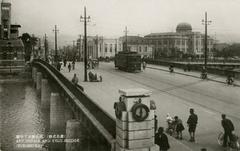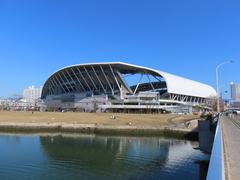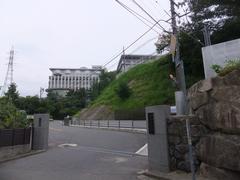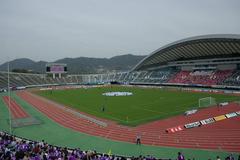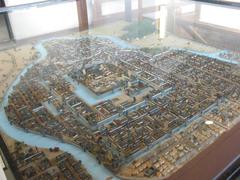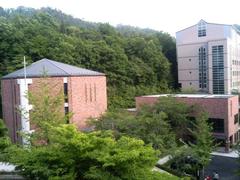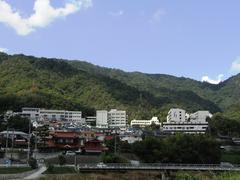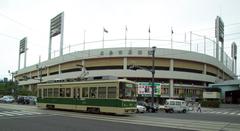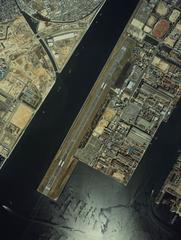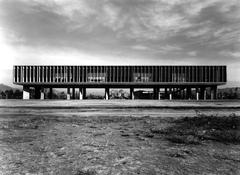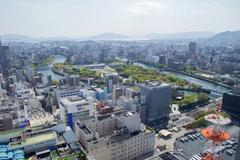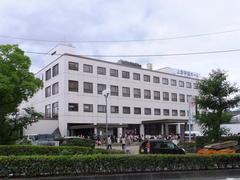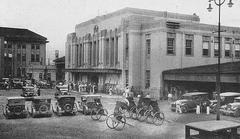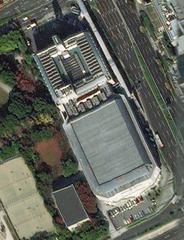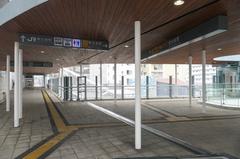Ōmachi Station Visiting Hours, Tickets, and Hiroshima Historical Sites Guide
Date: 04/07/2025
Introduction: Ōmachi Station at the Heart of Hiroshima
Ōmachi Station, located in Hiroshima’s northern Asaminami-ku district, stands as a pivotal gateway connecting the JR Kabe Line and the Astram Line rapid transit system. Since its opening in 1994, the station has grown into an essential interchange for both local commuters and visitors seeking to explore Hiroshima’s historical and cultural landmarks. With its modern infrastructure, universal accessibility, and strategic location, Ōmachi Station is more than just a transportation hub—it is your starting point for discovering Hiroshima’s resilient spirit, rich heritage, and vibrant urban life. The station’s proximity to major sites such as Hiroshima Peace Memorial Park, Hiroshima Castle, and Shukkeien Garden makes it indispensable for travelers looking to experience the best of the city. (World of Metro, Trip to Japan, Travel + Leisure Asia)
Quick Reference: Contents
- Ōmachi Station Overview & History
- Visiting Hours and Ticket Information
- Station Facilities & Accessibility
- Transfers and Transportation Tips
- Nearby Attractions & Historical Sites
- Seasonal Events & Local Experiences
- Frequently Asked Questions (FAQ)
- Visual Aids & Internal Resources
- Summary & Recommendations
- Sources & Official Links
Ōmachi Station Overview & History
Established in 1994 as an interchange for the JR Kabe Line and Astram Line, Ōmachi Station has played a key role in Hiroshima’s postwar urban development and expansion into northern districts. The Kabe Line dates to 1909, but it was the addition of the Astram Line that transformed Ōmachi into a modern transit hub, facilitating efficient movement between the city center and the suburbs. The station’s design—featuring elevated and ground-level platforms, covered overpasses, and robust accessibility features—reflects Hiroshima’s commitment to resilience, sustainability, and inclusive public infrastructure. (World History Journal)
Visiting Hours and Ticket Information
Operating Hours
- Station Hours: Daily, approximately 5:30 AM to midnight
- Ticket Machines: Available throughout operating hours, with multilingual support
- Staffed Assistance: Present during peak periods and for special events
Tickets & Fares
- Single Tickets: Purchase from vending machines for both JR Kabe Line and Astram Line; fares start at around 150–180 yen and increase with travel distance.
- IC Cards: ICOCA, PASPY, Suica, and other major IC cards are accepted for seamless tap-and-go access.
- Day Passes: Available at major stations and tourist centers for unlimited rides on Hiroshima’s public transit networks—recommended for visitors planning multiple trips.
- Tourist Passes: Special deals for tourists, often including discounts at partner attractions.
How to Purchase
- Use automated ticket machines (Japanese & English language support)
- Staffed counters assist during the day
- IC cards can be recharged at station kiosks and convenience stores
Station Facilities & Accessibility
Ōmachi Station is fully equipped to meet the needs of all travelers:
- Universal Accessibility: Elevators, escalators, tactile paving, ramps, and accessible restrooms ensure smooth navigation for wheelchair users, families, and elderly passengers.
- Restrooms: Clean, accessible, and equipped with baby-changing and nursing areas.
- Waiting Areas: Sheltered seating and climate-controlled indoor spaces.
- Retail & Dining: Convenience stores, kiosks, vending machines, and cafes.
- Luggage Storage: Coin lockers and a staffed baggage counter (daytime hours).
- Customer Service: Bilingual information desk, lost & found, digital displays, and real-time train updates.
- Connectivity: Free Wi-Fi and charging stations throughout the station.
- Bicycle Parking: Secure parking and integration with the Peacecle bike-share system.
- Bus & Taxi Access: Adjacent bus stops and a taxi stand for onward journeys.
(Hiroshima Electric Railway official site, Astram Line official site)
Transfers and Transportation Tips
- Line Transfers: Adjacent platforms for the Astram Line (elevated) and JR Kabe Line (ground level), linked by escalators, elevators, and clear bilingual signage. Transfers typically take 3–5 minutes.
- IC Cards: Strongly recommended for convenience and fare discounts; can be used interchangeably on trams, buses, and trains.
- Peak Hours: Avoid 7:30–9:00 AM and 5:00–7:00 PM for a more comfortable ride.
- Luggage: Use coin lockers to travel hands-free.
- Travel Apps: The Audiala app provides real-time transit updates, route planning, and digital ticketing.
Nearby Attractions & Historical Sites
Ōmachi Station serves as your link to Hiroshima’s most significant historical and cultural destinations:
- Hiroshima Peace Memorial Park & Museum: UNESCO World Heritage site, accessible via Astram Line to Hondori, then a short tram ride. Features the Atomic Bomb Dome and moving exhibits on peace and recovery. (Travel + Leisure Asia)
- Hiroshima Castle: A reconstructed feudal-era castle with a museum and cherry blossom gardens. Short tram ride from Ōmachi. (Get Hiroshima)
- Shukkeien Garden: Tranquil 17th-century Japanese garden with seasonal blooms and tea houses. (Explore City Life)
- Hondori Shopping Arcade: Bustling pedestrian street for shopping and local specialties, including Hiroshima-style okonomiyaki. (The Tourist Checklist)
- Okonomimura: Multi-story food complex dedicated to Hiroshima’s iconic okonomiyaki pancakes. (Touropia)
- Mitaki Temple: Serene, nature-surrounded temple, accessible by the Kabe Line from Ōmachi.
- Day Trips:
- Miyajima (Itsukushima Shrine): Famous for its floating torii, reached via JR and ferry. (Travel + Leisure Asia)
- Onomichi: Seaside town popular for cycling and temples. (The Tourist Checklist)
- Sandankyo Gorge: Renowned for hiking and river scenery, accessible by bus. (Explore Hiroshima)
Seasonal Events & Local Experiences
- Hiroshima Flower Festival (May): City-wide parades, music, and food stalls.
- Peace Memorial Ceremony (August 6): Annual event commemorating Hiroshima’s atomic bombing. (Japan Travel)
- Neighborhood Matsuri: Local festivals like Hoozuki Matsuri celebrate community traditions.
- Culinary Heritage: Sample Hiroshima’s famous oysters, momiji manju pastries, and street foods.
- Community Engagement: The station often hosts public art displays and local markets reflecting Hiroshima’s resilient spirit. (World History Journal)
Frequently Asked Questions (FAQ)
Q: What are Ōmachi Station’s operating hours?
A: Approximately 5:30 AM to midnight, with frequent train services during peak times.
Q: Can I use IC cards at Ōmachi Station?
A: Yes. ICOCA, PASPY, Suica, and other major IC cards are accepted on both the Astram Line and JR Kabe Line.
Q: Is Ōmachi Station wheelchair accessible?
A: Yes. The station features elevators, ramps, tactile paving, and accessible restrooms.
Q: Are there luggage storage options?
A: Yes. Coin lockers and a staffed baggage counter (daytime hours) are available.
Q: How do I reach Hiroshima Peace Memorial Park from Ōmachi?
A: Take the Astram Line to Hondori, then transfer to the tram line for the park.
Q: What amenities are nearby?
A: Convenience stores, cafes, ATMs, and Wi-Fi hotspots are located close to the station.
Visual Aids & Internal Resources
-
Image Suggestions:
- Ōmachi Station main entrance with clear bilingual signage
- Hiroden streetcar and Astram Line platforms
- Ticket machines with English instructions
- Accessibility features (elevators, tactile paving, ramps)
- Nearby attractions (Hiroshima Peace Memorial Park, Shukkeien Garden)
-
Alt Tags Examples:
- “Ōmachi Station Hiroshima main entrance with bilingual signage”
- “Hiroden streetcar platform at Ōmachi Station”
- “Automated ticket machine at Ōmachi Station with English instructions”
- “Elevator access for Astram Line platforms at Ōmachi Station”
-
Interactive Map:
- [Embed a map showing Ōmachi Station and key tourist destinations]
-
Related Articles:
Summary & Visitor Recommendations
Ōmachi Station is a vital nexus in Hiroshima’s transit network, providing seamless transfers between major lines and direct access to the city’s historical and cultural landmarks. Its comprehensive facilities—multilingual ticketing, universal accessibility, luggage storage, and staff support—ensure a smooth, comfortable experience for all travelers. The station’s role in Hiroshima’s postwar revitalization and ongoing commitment to sustainability and inclusivity is reflected in its design and community engagement.
Travelers are advised to use IC cards for efficient fare payment, avoid peak hours for comfort, and leverage digital tools such as the Audiala app for real-time updates and trip planning. For those seeking to explore Hiroshima’s historical treasures, vibrant neighborhoods, and culinary specialties, Ōmachi Station is the perfect starting point. Plan ahead, consult official resources, and immerse yourself in the rich culture and resilient spirit that defines Hiroshima.
Sources and Official Links
- World of Metro: Hiroshima Rapid Transit Astram Line
- Trip to Japan: Getting Around Hiroshima Transportation Tips
- Hiroshima Electric Railway official site
- Astram Line official site
- Living Nomads: Hiroshima Travel Blog
- World History Journal: Remarkable Hiroshima 2025
- Travel + Leisure Asia: Hiroshima, City of Peace
- Japan Travel: Events in Hiroshima
- Get Hiroshima
- Explore City Life: Hiroshima
- The Tourist Checklist: Things to Do in Hiroshima
- Touropia: Tourist Attractions in Hiroshima
- Explore Hiroshima: Top Attractions
All information is accurate as of July 2025. For the latest updates, please consult official Hiroshima transit websites and tourism portals.
